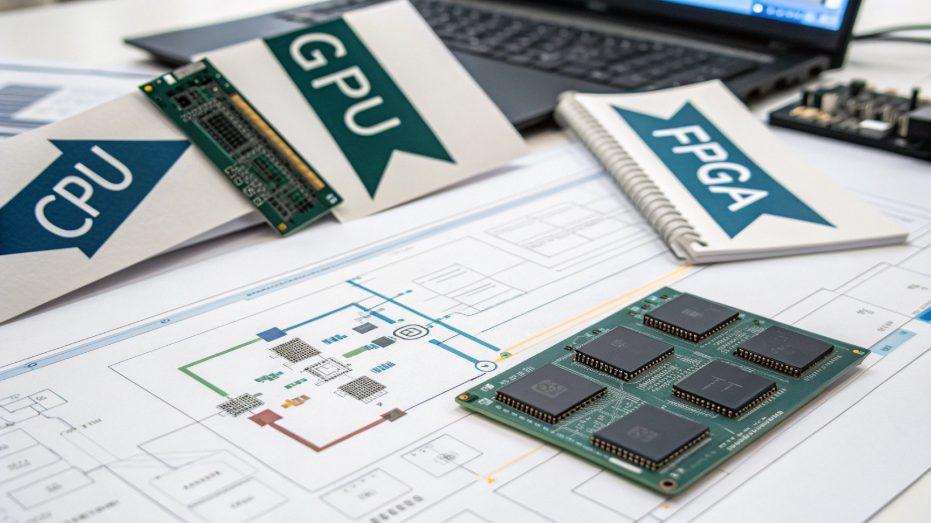Heterogeneous Computing: Golden Ratio of CPU+GPU+FPGA Fusion

Heterogeneous computing has emerged as a transformative force in the tech realm, redefining how we process complex workloads. At its core, the fusion of CPU, GPU, and FPGA architectures is gaining unprecedented traction, with researchers and engineers racing to uncover their optimal balance—the golden ratio. This synergy, when paired with robust infrastructure like Hong Kong hosting and colocation services, unlocks unparalleled computational potential. Let’s delve into the intricacies of this technological revolution.
Understanding Heterogeneous Computing: From Basics to Advantages
Heterogeneous computing refers to the integration of different types of processing units to execute diverse computational tasks efficiently. Unlike homogeneous systems relying on identical cores, heterogeneous setups leverage the unique strengths of each component. This approach offers:
- Enhanced parallel processing capabilities for data – intensive workloads
- Improved energy efficiency by matching tasks to the most suitable hardware
- Flexibility to adapt to evolving computational demands across industries
Deep Dive into Core Components
CPU: The Architect of Computational Coordination
The CPU, or Central Processing Unit, acts as the orchestrator in heterogeneous systems. Its strengths lie in:
- Handling sequential tasks and complex decision – making processes
- Managing system resources and coordinating data flow between components
- Executing general – purpose instructions with high single – thread performance
GPU: The Powerhouse of Parallel Processing
Graphics Processing Units (GPUs) excel in parallel computing, making them indispensable for:
- Large – scale matrix operations critical in machine learning algorithms
- Rendering high – resolution graphics and video processing
- Accelerating data throughput in parallelizable workloads
FPGA: The Adaptive Chameleon of Hardware
Field – Programmable Gate Arrays (FPGAs) offer unmatched flexibility through:
- Reconfigurable logic blocks that can be customized for specific tasks post – manufacturing
- Low – latency performance in real – time applications like signal processing
- Energy efficiency in fixed – function workloads compared to general – purpose chips
Decoding the Golden Ratio
Scenario – Specific Optimization
- AI Training: A GPU – heavy configuration (60 – 70% GPU, 20 – 30% CPU, 5 – 10% FPGA) dominates, as training demands massive parallelism. CPUs handle data preprocessing and model coordination, while FPGAs assist in specialized tensor operations.
- AI Inference: FPGAs gain prominence (30 – 40% FPGA, 30 – 40% CPU, 20 – 30% GPU) for low – latency responses. Their reconfigurability adapts to trained models, with CPUs managing workflow and GPUs handling residual parallel tasks.
- Big Data Processing: A balanced mix (40 – 50% CPU, 30 – 40% GPU, 10 – 20% FPGA) works best. CPUs manage data indexing and query execution, GPUs accelerate parallel data transformations, and FPGAs optimize I/O operations.
Technical Considerations Shaping the Ratio
- Performance Requirements: Latency – sensitive applications prioritize FPGAs, while throughput – focused tasks lean toward GPUs.
- Power Constraints: FPGAs shine in low – power environments, while GPU – intensive setups demand robust cooling solutions.
- Cost Efficiency: CPUs offer a cost – effective base, with GPUs and FPGAs adding incremental value based on task criticality.
Hong Kong’s Infrastructure: Catalyzing Heterogeneous Computing
Hong Kong’s hosting and colocation services provide a robust foundation for deploying heterogeneous architectures through:
- High – speed, low – latency connectivity to global data hubs, minimizing data transfer bottlenecks in distributed heterogeneous systems.
- Redundant power grids and advanced cooling systems that support the high – density requirements of GPU and FPGA clusters.
- Regulatory compliance and data security frameworks, ensuring secure operation of mission – critical heterogeneous workloads.
Real – World Applications
- Financial Services: FPGA – enhanced systems power high – frequency trading with microsecond – level latency, while GPUs analyze market trends in parallel, and CPUs manage transaction ledgers.
- Telecommunications: Heterogeneous setups process 5G network data—GPUs handle signal modulation, FPGAs optimize real – time routing, and CPUs coordinate network resources.
- Scientific Research: Climate modeling uses GPU – CPU hybrids for parallel simulations, with FPGAs accelerating sensor data processing from global monitoring networks.
Future Trajectories
The golden ratio will evolve with technological advancements:
- Emerging AI models may shift toward FPGA – GPU hybrids as model architectures become more specialized.
- Quantum computing integration could redefine ratios, with classical heterogeneous systems handling quantum – classical interfaces.
- Edge computing deployments will drive demand for compact, power – efficient ratios, favoring FPGA – CPU combinations.
Heterogeneous computing, with its CPU+GPU+FPGA fusion, is reshaping the tech landscape. Finding the golden ratio tailored to specific use cases, supported by robust infrastructure like Hong Kong’s hosting and colocation services, is key to unlocking its full potential. As technology advances, this synergy will continue to push the boundaries of what’s computationally possible.

